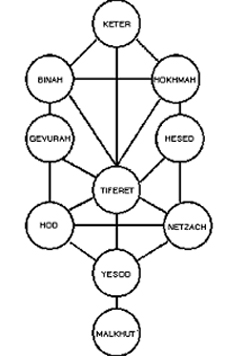 Sephirat Ha’Omer: seven weeks of spiritual practice, taking account of the elements – the sephirot — of spirit.
Sephirat Ha’Omer: seven weeks of spiritual practice, taking account of the elements – the sephirot — of spirit.
Remember the Periodic Table of the Elements from basic Chemistry? It’s a simple graphic, listing the elements of matter, arranged from the most rarified to the most dense.
 Kabbalistic tradition offers something like it: two diagrams of the sephirot, linear and circular.
Kabbalistic tradition offers something like it: two diagrams of the sephirot, linear and circular.
The linear model is anchored in three lines, like a human body: centre, right and left. Lines of sephirot flow from this stick body’s head down to its feet. The model tells a story: Once there was a primordial human being who contained all the possibilities of creation. We could recover these possibilities, if we develop a skilled mind.
 The concentric circle model shows a set of nested sephirot. The outer circle is the most ineffable element; the centre circle is the most familiar. The model mimics ancient drawings of the universe: our familiar earth encircled by its atmosphere, its solar system, its galaxy, its quadrant, its universe, its creator. The diagram show us tiny yet protected, nestled within a complex divine body and a great cosmological process.
The concentric circle model shows a set of nested sephirot. The outer circle is the most ineffable element; the centre circle is the most familiar. The model mimics ancient drawings of the universe: our familiar earth encircled by its atmosphere, its solar system, its galaxy, its quadrant, its universe, its creator. The diagram show us tiny yet protected, nestled within a complex divine body and a great cosmological process.
Two shapes; two stories. Two templates; two teachings. In each case, order, design, and boundaries shape what we see. That’s gevurah: the meaningful boundary.
Gevurah is the work of Elohim – God’s character in the Torah’s creation story. God speaks the chaos into shape, carving designs with sound. Notice Elohim’s work in the diversity of rocks, plants, and animals. In their predictable interactions. In the surprise developments when one adjusts to the other. Can we walk through the week with wonder at the world’s design?
Gevurah is present in human speech, too. Our feelings shape our breath; our mouths form breath into words. Our minds design sentences, monologues, conversations. Notice the complex vowel pattern in the word Gevurah, which also means military might. Eh-oo-ah. It’s the same pattern as Refuah, healing. Will we choose harmful or healing patterns of speech? How can we consciously perfect our conversational boundaries?
Gevurah, some teachers say, shines with red light. Red, the colour of blood. Of life. And death. “If am I not for myself who will be?” asks our teacher Hillel, because good boundaries can save life. “If I am only for myself, then what am I?” he adds, because strict boundaries can leave another to die. We can learn the practical wisdom to measure Gevurah correctly. What local resources will we find?
Circular sephirot: David Friedman. Helpful scholarly source: Sanford Drob.


Thank you, for the “play” of gEhvUu Ah refuah, yes, and then came : metukah and then I understood the Holy challenge of the right measure/pattern of gevurah: Teshuvah (or Jeshuah) !!!!! So there we go: from constriction/too much density or self solidtity via differentiation/splitting and healing/wholing into the sweetening of tasting redemption…… WOW !!!! Makes the journey through gevurah much lighter.
Thanks, Carola. I love your connection here with metuka. Challenges may be part of the structure of the universe, but so is the desire of most creatures to live in peace and health.